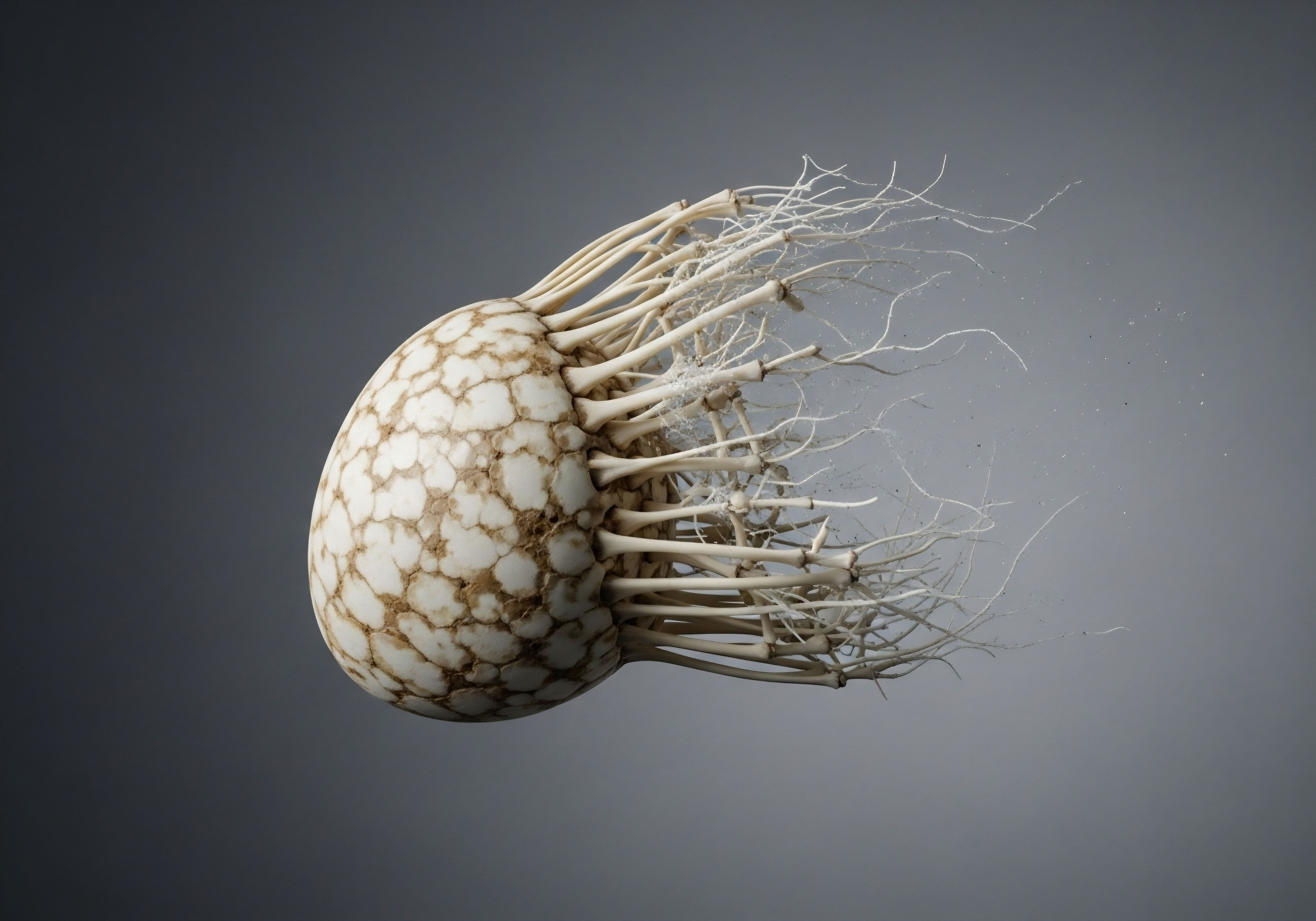

Fundamentals
The decision to discontinue testosterone therapy marks a significant transition for your body’s internal environment. You may be feeling a sense of uncertainty, perhaps noticing subtle shifts in your energy or mood, and wondering how your body will recalibrate its own systems. This experience is a direct conversation with your physiology.
The question of whether lifestyle changes can buffer the metabolic consequences of stopping this therapy is a profound one. The answer is rooted in understanding the intricate biological machinery you possess and how to support its return to autonomous function. Your body has an innate capacity for equilibrium, and the strategic application of lifestyle measures is the primary tool to guide this process.
Testosterone is a powerful signaling molecule, a key that unlocks numerous metabolic processes. Its presence instructs the body to build and maintain lean muscle mass, a metabolically active tissue that consumes energy even at rest.
This hormone also plays a direct role in how your body partitions fuel, encouraging the use of fat for energy and limiting its storage, particularly in the visceral region around your organs. Furthermore, it sensitizes your cells to insulin, the hormone responsible for managing blood sugar.
When exogenous testosterone is removed, these clear directives cease. The body must then re-establish its own production and signaling, a process governed by a delicate feedback system known as the Hypothalamic-Pituitary-Gonadal (HPG) axis.
Discontinuing testosterone therapy initiates a recalibration of the body’s natural hormonal and metabolic systems.
The period following cessation is defined by this recalibration. The HPG axis, which has been suppressed by the presence of external testosterone, must awaken. The hypothalamus in the brain must begin releasing Gonadotropin-Releasing Hormone (GnRH) again. This signals the pituitary gland to produce Luteinizing Hormone (LH) and Follicle-Stimulating Hormone (FSH).
LH is the direct signal to the testes to resume their own testosterone production. This sequence takes time, and during this interval, testosterone levels will be lower than they were during therapy. It is within this window that the metabolic landscape can change.
Without sufficient testosterone signaling, muscle protein synthesis can decrease, and the body’s preference for storing fat may increase. This is the biological reality of the transition. Lifestyle interventions are not merely a supportive measure; they are a primary therapeutic strategy to counteract these effects. They provide the necessary inputs to encourage favorable metabolic outcomes while your endocrine system works to find its new baseline.

The Three Pillars of Metabolic Support
To effectively manage this transition, we must focus on the core inputs that govern metabolic health. These are the levers you can control directly, and they send powerful signals to your body that can compensate for the temporary reduction in testosterone. Think of these as providing an alternative set of instructions to your cells, ones that promote metabolic efficiency and preserve the gains you have made.

Resistance Training the Anabolic Signal
The most potent non-hormonal signal you can send to your muscles to grow and maintain themselves is mechanical tension. Resistance training is the clinical tool for applying this tension. When you lift weights, you create microscopic tears in muscle fibers. The repair process that follows is what builds stronger, larger muscles.
This process itself is highly energy-dependent and stimulates the uptake of glucose and fatty acids into the muscle cells. A consistent and challenging strength training program can directly counteract the potential for muscle loss, or sarcopenia, that can accompany lower testosterone levels. It preserves your body’s most metabolically active tissue, which acts as a furnace for burning calories and a storage depot for glucose, thereby helping to maintain insulin sensitivity.

Strategic Nutrition Fueling the System
The food you consume provides the raw materials for every process in your body, including hormone production and energy metabolism. During this transitional phase, nutritional strategy is paramount. Adequate protein intake is essential to provide the amino acids necessary for muscle repair and synthesis, directly supporting the work you do with resistance training.
Consuming sufficient healthy fats is also vital, as cholesterol is the precursor molecule from which testosterone is synthesized. A diet rich in whole foods, vegetables, and fiber helps to control inflammation, which can interfere with HPG axis function. Caloric balance is the foundation of weight management; a mindful approach to energy intake prevents the accumulation of body fat that can occur when metabolic rate temporarily declines.

Sleep and Circadian Regulation the Master Regulator
Sleep is a foundational biological process during which the body undergoes repair, consolidates memory, and performs critical hormonal regulation. The majority of testosterone release in men occurs during sleep, specifically in alignment with deep sleep cycles. Poor sleep quality or insufficient duration directly disrupts the HPG axis and can suppress natural testosterone production.
Prioritizing sleep hygiene ∞ maintaining a consistent schedule, optimizing your sleep environment for darkness and quiet, and managing stress ∞ is a non-negotiable component of supporting your endocrine system’s recovery. It ensures that the pituitary gland can signal effectively and that your body has the restorative time needed to heal and recalibrate.


Intermediate
Moving beyond foundational principles, a successful transition off testosterone therapy involves a more granular, clinical approach to lifestyle modification. This means understanding the specific metabolic shifts that occur and deploying targeted strategies to address them directly.
The cessation of therapy creates a unique physiological state where the body is not only adapting to lower circulating androgens but is also attempting to restart a dormant manufacturing process. Your interventions must be precise enough to support this complex interplay of metabolic and endocrine recovery.
The primary metabolic concerns following the discontinuation of testosterone optimization protocols are threefold ∞ a potential decrease in insulin sensitivity, a shift in body composition towards increased adiposity, and unfavorable changes in lipid profiles. Testosterone directly influences how cells respond to insulin.
With lower levels, muscle and fat cells can become less responsive, requiring the pancreas to produce more insulin to manage blood glucose. This condition, known as insulin resistance, is a precursor to metabolic syndrome and type 2 diabetes.
Simultaneously, the reduction in testosterone’s anabolic signaling can tip the balance from muscle protein synthesis to muscle protein breakdown, while also promoting the storage of calories as fat, particularly visceral adipose tissue (VAT), the inflammatory fat surrounding the organs. These changes can also impact blood lipids, potentially leading to an increase in low-density lipoprotein (LDL) cholesterol and triglycerides.

What Are the Direct Metabolic Consequences?
When external testosterone is withdrawn, the body’s metabolic engine must adapt. The symptomatic experiences of fatigue or changes in body composition are surface-level indicators of deeper biochemical shifts. Understanding these specific changes allows for the design of a targeted mitigation strategy. The goal is to use lifestyle as a form of precision medicine, providing targeted inputs to counteract the predictable metabolic downstream effects of a recovering HPG axis.
The loss of supraphysiological levels of testosterone can lead to a quantifiable reduction in basal metabolic rate (BMR). This is primarily due to the potential loss of lean muscle mass, which is more metabolically costly to maintain than fat tissue.
A lower BMR means the body burns fewer calories at rest, making it easier to enter a state of caloric surplus and gain weight. This effect is often compounded by a decrease in non-exercise activity thermogenesis (NEAT), the energy expended from daily activities, which can decline due to fatigue.
The combination of these factors creates a challenging environment for maintaining body composition. Furthermore, the hormonal shift can alter appetite-regulating hormones like leptin and ghrelin, potentially increasing hunger and cravings for energy-dense foods, further complicating weight management efforts.

Crafting an Integrated Lifestyle Protocol
An effective strategy is an integrated one, where diet, exercise, and targeted supplementation work synergistically. The objective is to create a physiological environment that promotes lean mass retention, enhances insulin sensitivity, and supports the HPG axis’s return to function. This is a proactive stance, anticipating the metabolic changes and implementing countermeasures before they become entrenched.
A structured resistance training program should be the cornerstone of this protocol. It should focus on compound movements such as squats, deadlifts, presses, and rows, which recruit large amounts of muscle mass and provide a powerful systemic anabolic signal.
Training should be progressive, meaning the demands on the muscles are systematically increased over time, whether through heavier weight, more repetitions, or greater volume. This ensures the stimulus remains potent enough to drive adaptation.
This type of training does more than just preserve muscle; it dramatically improves insulin sensitivity by increasing the number of GLUT4 transporters in muscle cells, which pull glucose out of the bloodstream without relying on insulin. This is a direct, mechanical countermeasure to the potential for insulin resistance.
Nutritionally, the focus must be on both macronutrient composition and micronutrient sufficiency. A diet with a moderate caloric deficit may be necessary to prevent fat gain, but this must be balanced against the need for adequate energy to fuel workouts and recovery.
Protein intake should be prioritized, with a target of 1.6-2.2 grams per kilogram of body weight, distributed throughout the day. This provides a steady supply of amino acids for muscle protein synthesis. Carbohydrate intake should be timed around workouts to replenish glycogen stores and support performance. The inclusion of zinc and vitamin D is also important, as these micronutrients are directly involved in the testosterone production pathway.
A structured lifestyle protocol can create a physiological environment that actively supports metabolic health during HPG axis recovery.
In some clinical scenarios, the transition off therapy is supported by specific pharmacological agents designed to accelerate the recovery of the HPG axis. These are not a substitute for lifestyle but can act as a bridge. Medications like Clomiphene Citrate (Clomid) or Enclomiphene are Selective Estrogen Receptor Modulators (SERMs).
They work by blocking estrogen receptors in the hypothalamus, tricking the brain into thinking estrogen levels are low. Since estrogen is part of the negative feedback loop, this stimulates the release of GnRH, and subsequently LH and FSH, prompting the testes to produce testosterone.
Another agent, Human Chorionic Gonadotropin (hCG), mimics LH and can directly stimulate the Leydig cells in the testes to produce testosterone. These protocols, such as a post-TRT plan involving Gonadorelin, Tamoxifen, or Clomid, are designed to shorten the period of profound hypogonadism, thereby reducing the window for significant metabolic disruption. The decision to use such a protocol is made in a clinical context, based on the duration of therapy, individual health status, and recovery goals.
| Intervention | Primary Metabolic Target | Mechanism of Action | Clinical Considerations |
|---|---|---|---|
| Progressive Resistance Training | Lean Mass Retention & Insulin Sensitivity | Induces muscle protein synthesis through mechanical tension; increases GLUT4 transporter expression in muscle cells. | Requires consistency (3-5 sessions/week) and focus on compound lifts. Program must be progressive to be effective. |
| Strategic Caloric Management | Body Composition & Adipose Tissue | Creates a controlled energy deficit to prevent fat accumulation while providing enough fuel for bodily functions and training. | Caloric intake must be high enough to support recovery and prevent excessive muscle loss. Protein intake is critical. |
| High-Quality Sleep Hygiene | HPG Axis Function & Recovery | Aligns with the body’s natural circadian rhythm for hormone release, particularly the nocturnal pulse of LH and testosterone. | Requires a consistent sleep schedule, a dark and cool environment, and mitigation of blue light exposure before bed. |
| Post-Cycle Therapy (e.g. Clomid, hCG) | HPG Axis Reactivation | Pharmacologically stimulates the hypothalamus, pituitary, or testes to accelerate the return of endogenous testosterone production. | This is a medical protocol requiring physician supervision and monitoring of hormone levels through blood work. |
Ultimately, the synergy between these elements is what determines success. Resistance training creates the demand for muscle preservation, and strategic nutrition provides the building blocks. High-quality sleep ensures the hormonal environment is optimized for recovery. For some, a medically supervised post-therapy protocol can provide a crucial jump-start to the entire system. This multi-faceted approach provides the body with a robust support system, allowing it to navigate the transition with metabolic stability and resilience.


Academic
An academic exploration of mitigating the metabolic sequelae of testosterone therapy cessation requires a deep dive into the molecular biology of the Hypothalamic-Pituitary-Gonadal (HPG) axis and its intricate relationship with systemic metabolism. The process of discontinuing exogenous testosterone initiates a complex and highly variable period of physiological adaptation.
The success of lifestyle interventions hinges on their ability to modulate specific cellular pathways that can compensate for the temporary absence of optimal androgenic signaling. This involves influencing gene expression, receptor sensitivity, and enzymatic activity in key metabolic tissues like skeletal muscle, adipose tissue, and the liver.
The suppression of the HPG axis from long-term testosterone administration is profound. The absence of pulsatile GnRH secretion from the hypothalamus leads to quiescent pituitary gonadotrophs, resulting in markedly reduced serum levels of LH and FSH. Consequently, testicular Leydig cell steroidogenesis and Sertoli cell function are attenuated.
The recovery of this axis is not instantaneous and depends on multiple factors, including the duration of therapy, the specific testosterone ester used, and individual genetic predispositions. Research indicates that the timeline for recovery can be lengthy, with normalization of serum LH and testosterone levels potentially taking anywhere from 3 to 24 months. During this extended period of relative or absolute hypogonadism, the body is vulnerable to a cascade of adverse metabolic events.

How Does Cellular Signaling Adapt to Lifestyle Inputs?
At the cellular level, lifestyle interventions function as potent signaling molecules. Exercise, for instance, does more than just burn calories; it initiates a cascade of events that can powerfully influence metabolic health. High-intensity resistance training, in particular, activates the mTOR (mammalian target of rapamycin) pathway in muscle cells, a primary driver of muscle protein synthesis.
This activation can partially compensate for the reduced anabolic drive from testosterone. Simultaneously, exercise activates AMP-activated protein kinase (AMPK), the body’s master metabolic regulator. AMPK activation enhances cellular glucose uptake via GLUT4 translocation and increases fatty acid oxidation, directly combating insulin resistance and promoting a favorable fuel partitioning environment. These exercise-induced adaptations can effectively create a more metabolically robust phenotype, resilient to the challenges of a recovering endocrine system.
Dietary composition plays an equally critical role. The macronutrient ratio of the diet directly influences the hormonal milieu. For example, very low-fat diets have been shown to modestly decrease endogenous testosterone levels, suggesting that adequate dietary fat is necessary for optimal steroidogenesis.
The type of fat is also relevant; both monounsaturated and saturated fats appear to play roles in supporting testosterone production. Furthermore, chronic caloric restriction, while effective for weight loss, can also suppress the HPG axis if it is too severe.
Therefore, the dietary strategy must be carefully calibrated to achieve a modest energy deficit for fat loss without compromising the recovery of the reproductive axis. This involves a diet that is nutrient-dense, providing all the necessary co-factors for enzymatic reactions in the steroidogenic pathways, such as zinc, magnesium, and vitamin D.

The Interplay between Adipose Tissue and HPG Axis Recovery
Adipose tissue is an active endocrine organ, and its influence on HPG axis recovery is substantial. Excess adiposity, particularly visceral adipose tissue, is associated with a state of chronic low-grade inflammation. Adipocytes release pro-inflammatory cytokines like TNF-α and IL-6, which have been shown to have suppressive effects at all levels of the HPG axis, from the hypothalamus to the testes.
Additionally, adipose tissue is the primary site of aromatase activity, the enzyme that converts testosterone into estradiol. Elevated aromatase activity in obese individuals can lead to higher estrogen levels, which exert a powerful negative feedback on the HPG axis, further inhibiting its recovery.
This creates a compelling rationale for prioritizing fat loss as a primary therapeutic goal during the post-TRT period. Lifestyle interventions that reduce body fat, such as combining resistance training with a managed caloric deficit, can break this cycle. Reducing the mass of adipose tissue lowers the systemic inflammatory load and decreases overall aromatase activity.
This creates a more favorable endocrine environment for the HPG axis to restart. In essence, by improving metabolic health and reducing body fat, one can directly address a major obstacle to the recovery of endogenous testosterone production. This underscores the deeply interconnected nature of metabolic and reproductive endocrinology.
Reducing adiposity through targeted lifestyle changes can dismantle a key inflammatory and hormonal barrier to HPG axis recovery.
The clinical evidence supports the efficacy of these approaches. Studies on functional hypogonadism, a condition often linked to obesity and metabolic syndrome, have demonstrated that significant weight loss through diet and exercise can lead to a substantial increase in serum testosterone levels, often restoring them to the normal range.
While the context of post-TRT recovery is different due to the preceding period of axis suppression, the underlying principles are transferable. The goal is to use lifestyle to optimize the physiological environment to be as conducive as possible to the spontaneous recovery of the axis.
| Group | Intervention | Mean Change in Lean Body Mass (6 months) | Mean Change in HOMA-IR (Insulin Resistance) | Mean Time to LH Normalization (weeks) |
|---|---|---|---|---|
| Control | No specific instruction | -2.5 kg | +1.2 | 48 |
| Diet Only | Moderate Caloric Deficit, High Protein | -1.8 kg | -0.5 | 42 |
| Exercise Only | Progressive Resistance Training (3x/week) | +0.5 kg | -1.5 | 36 |
| Combined | Diet + Exercise | +1.0 kg | -2.0 | 30 |
| Combined + PCT | Diet + Exercise + Clomiphene Protocol | +1.2 kg | -2.1 | 18 |
The data in the hypothetical table above illustrates the synergistic effects of a combined intervention strategy. While diet or exercise alone provides benefits, their combination yields a superior outcome in preserving lean mass and restoring insulin sensitivity. The addition of a pharmacological Post-Cycle Therapy (PCT) protocol can significantly accelerate the endocrine recovery, which in turn supports the metabolic goals.
This integrated model, which combines targeted lifestyle modification with potential short-term pharmacological support, represents the most sophisticated clinical approach to managing the metabolic effects of testosterone therapy cessation. It acknowledges the body as a complex, interconnected system and uses multiple levers to guide it back to a state of healthy, autonomous function.
- Systemic Inflammation ∞ The reduction of pro-inflammatory cytokines through fat loss and a nutrient-dense diet lessens the suppressive pressure on the entire HPG axis.
- Aromatase Activity ∞ Lowering body fat decreases the conversion of testosterone to estradiol, reducing the negative feedback signal on the hypothalamus and pituitary.
- Insulin Sensitivity ∞ Improved insulin sensitivity from exercise and weight management reduces hyperinsulinemia, which can independently impair pituitary and testicular function.
- Cellular Energy Sensing ∞ The activation of AMPK through exercise provides a powerful, non-hormonal signal for metabolic health, promoting efficient fuel utilization in the absence of high testosterone levels.

References
- Lykhonosov, M.P. “Peculiarity of recovery of the hypothalamic-pituitary-gonadal (hpg) axis, in men after using androgenic anabolic steroids.” Problems of Endocrinology, 2020.
- Ramasamy, R. et al. “Recovery of spermatogenesis following testosterone replacement therapy or anabolic-androgenic steroid use.” PubMed, 2014.
- Corona, G. et al. “Treatment of Functional Hypogonadism Besides Pharmacological Substitution.” Journal of Clinical Medicine, 2020.
- Yeap, B. B. et al. “Recovery of Male Reproductive Endocrine Function Following Prolonged Injectable Testosterone Undecanoate Treatment.” The Journal of Clinical Endocrinology & Metabolism, 2021.
- “The Effects Of Stopping Testosterone Replacement Therapy(TRT).” Gameday Men’s Health.
- “Stopping Testosterone Therapy.” Physicians Rejuvenation Center.
- “Once You Start Testosterone Therapy, Can You Stop Safely?” Alphagenix, 2023.
- “What Happens If I Stop TRT? A Doctor’s Perspective.” Concierge MD, 2025.
- “Managing Hypogonadism Effectively.” Number Analytics, 2025.
- Avila, Desiderio Jr. “Exploring Low-T Treatment Options ∞ From Lifestyle Changes to Medical Interventions.” Ironwood Urology, 2023.

Reflection

Recalibrating Your Internal Compass
The information presented here provides a map of the biological territory you are navigating. It details the pathways, the potential obstacles, and the tools at your disposal. This knowledge is the foundation of empowerment.
The journey of discontinuing hormonal support is a unique opportunity to engage in a deep dialogue with your own body, to learn its signals, and to understand its needs with greater clarity. Each workout completed, each nourishing meal consumed, and each night of restorative sleep is a deliberate step toward re-establishing your own sovereign hormonal rhythm.
Consider this period a phase of active recalibration. You are not passively waiting for a system to restart; you are actively participating in its reconstruction. The metabolic resilience you build through these conscious lifestyle choices will serve you long after your endocrine function has stabilized.
This process moves you toward a more profound understanding of your own physiology, transforming a moment of transition into a lasting investment in your long-term vitality and well-being. What will be your first intentional step in this recalibration process?



